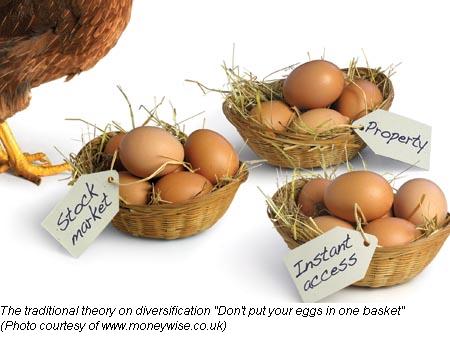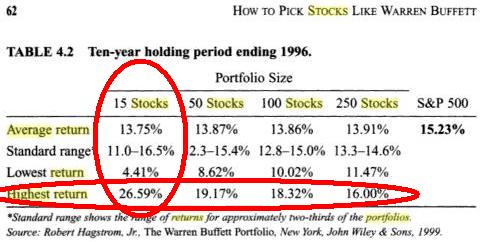This is the fourth blog post that I have written in response to several questions asked by an accountancy student from the University of the Philippines Visayas (Cebu Campus) regarding the Philippine stock market. As I have said before, I have responded via a blog post because the answers I am giving are quite lengthy not to mention the chance and opportunity to inform the public about value investing and investing in the Philippine stock market.
The previous questions and answers to such questions are found in these posts:
“Questions and answers on the Philippine stock exchange”
“The best asset allocation strategy to follow.”
“Determining the best rate of return for investments”
Actually this is a series of questions that were raised in a comment. To appreciate and learn more from her questions, I suggest that you read the previous posts. The next set of questions is as follows
“. . . Now, we’re down to the portfolio diversification and security selection . . . Which industry do you think is appropriate to invest in during these times? Actually, we have ‘randomnly’ picked some companies (given the many listed companies at PSE) without no basis at all . . .. . . we’re still undecided as to the allocation percentages but we’re putting more weight loss on IT, Food and Beverage, Medical and Telecommunication. . .”
Here is my response to the above questions:
Dear Enji,
Sorry for the late response, I had been busy with other matters
Your question talks mainly about portfolio diversification. Although you seem to be asking two questions, the second one being “Security selection.” Both questions can be given a single answer. You will have to read between the lines to know what the answer is. (Anyway I will give you a conclusion):-)
Wikipedia defines diversification in finance as “a risk management technique, related to hedging, that mixes a wide variety of investments within a portfolio.” Another definition of diversification given is that it is “the spreading out investments to reduce risks.”
In other words the main purpose of portfolio diversification is to reduce risk. In lay man’s term it is, proverbially speaking “Not to put your eggs in one basket.” Of course everybody understands the meaning of that and that is if the basket gets lost, you loose all your eggs. Therefore according to this theory, in investing in the stock market you should not put your investments in one stock or place it in several stocks in the same industry because if the stock goes down, then your investment goes down the drain as well.

Portfolio diversification is plain and simple common sense. A sensible man would indeed adhere to this theory.
Portfolio diversification in finance usually involves three stages. First, the portfolio is distributed among multiple investment vehicles, such as stocks, mutual funds, bonds, and cash.
Secondly the risk in investments is varied by applying portfolio diversification in the different vehicles of investment. For example investment in mutual funds are diversified to funds that use different strategies (Examples of such are growth funds, balanced funds, index funds, small cap, and large cap funds)
In the stock market, portfolio diversification may be done by industry. For example, instead of putting all investments in a certain property stock, the investments are spread out in other industries (such as holdings, financials etc. )
The last stage is diversification by geography, that is investments will be distributed in industrialized nations, emerging economies, among others to maximize the rate of return.
As you can see diversification is very simple and requires only plain common sense. In the Philippine stock market since we only have six industries (financial, industrial, holding firms, property, services, mining and oil), professionals would recommend that in order to apply proper portfolio diversification, you should place your stock in two or three industries. They would add that investing in all industries is all securities would be ideal since the more “baskets” you put your eggs into; the more the risk is reduced.
This is the heart and soul of portfolio diversification in Modern Portfolio Theory. MPT teaches that rational investors will apply portfolio diversification in their investments to reduce the risk of loss and to maximize their returns. The more you portfolio diversification there is, the more you reduce risk.
You cannot believe the math involved in MPT when it comes to portfolio diversification. It is not your ordinary day today. It involves doing math the “has greek letters on it.” The math involved is beyond the comprehension of the ordinary investor. In MPT, the selection process for a certain security to apply the portfolio diversification theory becomes very mathematically complicated that to come up with a solution quickly you will need to plug the numbers into the computer. Somehow this gives the ordinary investor a feeling that investing in the stock market is best left to the “professionals.”
So now you know what most investment professionals teach about portfolio diversification. As always after I tell you what the “norm” is, I will also point out to you what Warren Buffet thinks about portfolio diversification. According to Warren Buffett, diversification “ . . . is a protection against ignorance. It makes very little sense for those who know what they’re doing.”
Weird hugh ? So why does the Oracle of Omaha issue such rash statement about portfolio diversification, a principle that makes a lot of common sense? To understand this let me explain.
Let me point out that Buffett is not totally against portfolio diversification. The most number of stocks he holds in publicly listed companies is about 15 or less. However take note of what he said about portfolio diversification through investing shares of stocks in all stocks in the stock market, “By periodically investing in an index fund, the know-nothing investor can actually outperform most investment professionals.” (Investing in all stocks in the stock market is best achieved through investing in an index fund, that is a mutual fund that mimics the return of a certain stock market by buying shares of stocks in all stocks listed in a certain exchange. One Philippine Index fund I know is the Philequity PSE Index Fund)
What Buffett is against is “over diversification” this includes most of the portfolio diversification theories that are taught in Modern Portfolio Theory.
 Warren Buffett used to quip, “I can’t be involved in 50 or 75 things. That’s a Noah’s Ark, way of investing– you end up with a zoo. I like to put meaningful amounts of money in a few things.” Instead of portfolio diversification, what Warren Buffett is strongly recommending is “focus investing.” Focus investing is simply limiting your portfolio to a few stocks that is a few wonderful companies that has durable competitive advantage. Take note that his above statement on portfolio diversification through investing in an index fund is directed at the “know-nothing” investor. If you are an investor who knows what you are doing in the stock market here is Warren Buffet’s advice when it comes to portfolio diversification:
Warren Buffett used to quip, “I can’t be involved in 50 or 75 things. That’s a Noah’s Ark, way of investing– you end up with a zoo. I like to put meaningful amounts of money in a few things.” Instead of portfolio diversification, what Warren Buffett is strongly recommending is “focus investing.” Focus investing is simply limiting your portfolio to a few stocks that is a few wonderful companies that has durable competitive advantage. Take note that his above statement on portfolio diversification through investing in an index fund is directed at the “know-nothing” investor. If you are an investor who knows what you are doing in the stock market here is Warren Buffet’s advice when it comes to portfolio diversification:
“If you are a know-something investor, able to understand business economics and to find five to ten sensibly priced companies that possess important long-term competitive advantages, conventional portfolio diversification (broadly based active portfolios) makes no sense for you.
 Robert Hagstorm in his book “The Warren Buffett way” explains one of the reasons why Warren Buffett’s “Focused investing” approach makes more sense than the traditional MPT portfolio diversification approach. In page 25 of the Warren Buffett Way Hagstorm writes, “What’s wrong with conventional portfolio diversification? For one thing, it greatly increases the chances that you will buy something you don’t know enough about. Philip Fisher, who was known for his focus portfolios, although he didn’t use the term, profoundly influenced Buffett’s thinking in this area. Fisher always said he preferred owning a small number of outstanding companies that he understood well to a large number of average ones, many of which he understood poorly. “(Click here to get a copy of “The Warren Buffett way at my Guerilla blogger eStore)
Robert Hagstorm in his book “The Warren Buffett way” explains one of the reasons why Warren Buffett’s “Focused investing” approach makes more sense than the traditional MPT portfolio diversification approach. In page 25 of the Warren Buffett Way Hagstorm writes, “What’s wrong with conventional portfolio diversification? For one thing, it greatly increases the chances that you will buy something you don’t know enough about. Philip Fisher, who was known for his focus portfolios, although he didn’t use the term, profoundly influenced Buffett’s thinking in this area. Fisher always said he preferred owning a small number of outstanding companies that he understood well to a large number of average ones, many of which he understood poorly. “(Click here to get a copy of “The Warren Buffett way at my Guerilla blogger eStore)
In his 1993 Chairman’s letter to shareholders Buffett has this to say about portfolio diversification “The strategy we’ve adopted precludes our following standard portfolio diversification dogma. Many pundits would therefore say the strategy must be riskier than that employed by more conventional investors. We disagree. We believe that a policy of portfolio concentration may well decrease risk if it raises, as it should, both the intensity with which an investor thinks about a business and the comfort-level he must feel with its economic characteristics before buying into it.”
So there you have it! The first reason why you should focus your investment in only a few outstanding stocks is because it will increase your chances of buying something you don’t understand. Over portfolio diversification will also make you have too many companies to monitor. You will never get to know each company very well. This goes against the very heart of value investing and that is that you must only invest in something that you understand. Buffett likened “over portfolio diversification” to having a harem of 40 women. According to him “. . . you never get to know any of them very well.” Add to this is the fact that over diversification will divert your focus and energies from truly sorting out the wheat from the chaff.
 The second reason as to why investor’s should follow Buffett’s focused investing approach is discussed by Timothy Vicks in his book “How to pick stocks like Warren Buffett.” In pages 60 to 62 of said book, Vicks mentioned a study conducted by Robert Hagstorm in 1999. He writes that based on the study, “ . . .portfolios with the largest number of stocks tended to post returns that barely deviated from the mean return of all similarly sized portfolios. The smallest portfolios, in contrast, offered the highest deviation of average returns . . . “ (See table below) (Want to get a copy of “How to pick stocks like Warren Buffett” Click here)
The second reason as to why investor’s should follow Buffett’s focused investing approach is discussed by Timothy Vicks in his book “How to pick stocks like Warren Buffett.” In pages 60 to 62 of said book, Vicks mentioned a study conducted by Robert Hagstorm in 1999. He writes that based on the study, “ . . .portfolios with the largest number of stocks tended to post returns that barely deviated from the mean return of all similarly sized portfolios. The smallest portfolios, in contrast, offered the highest deviation of average returns . . . “ (See table below) (Want to get a copy of “How to pick stocks like Warren Buffett” Click here)

So, the second reason why investors should avoid over diversification and should maintain a focused portfolio of a few outstanding companies with a durable competitive advantage is because this gives the investor a much greater chance of beating the market.
Now going back to your question as to which industry you should invest in for portfolio diversification purposes the answer is, ANY COMPANY IN ANY INDUSTRY for as long as these are wonderful companies with durable competitive advantage! As to what are wonderful companies with durable competitive advantage that question has to be answered in another post. I’ll probably include that in the next post since I will be answering your questions on valuation techniques.
I hoped I have filled your day once again with simple and practical wisdom from the world’s greatest investor.
Till then,
The Guerilla blogger-investor
 Hi ! my name is Zigfred Diaz. Thanks for visiting my personal blog ! Never miss a post from this blog. Subscribe to my full feeds for free. Click here to subscribe to zdiaz.com by Email
Hi ! my name is Zigfred Diaz. Thanks for visiting my personal blog ! Never miss a post from this blog. Subscribe to my full feeds for free. Click here to subscribe to zdiaz.com by Email
You may also want to visit my other blogs. Click here to learn more about great travel ideas.


wow..speakin like the world’s greatest himself. its great to find another value blogger..especially one from cebu. keep it up sir
im guessing the next psot would be about moats. hehe
xoutdeyes: heheheheh thanks ! Well part of the next post will certainly talk about moats hehehehehe
Hi, comment lang for the accounting student. I’m not saying that diversification is a bad approach since it is a viable strategy when buying stocks (ginagawa nga ng institutional entitities yun eh). But if you’re planning to just randomly pick companies from certain business sectors and then allocate a specified amount of capital per company, e bat hindi ka na lang bumili ng UITF or mutual fund? My point is if you’re going to emulate what the insttitutional buyers do anyway, why not invest in them and save yourself the trouble? Yun nga lang, may holding period so you won’t be as liquid as you want (parang 90 days min holding period yung alam kong stock- UITF d2 sa pinas)…
A downside I can see in such an approach is your profits will be more dependent on the performance of the market as a whole. That entails minimal loss when a particular sock price goes sour, which also entails minimal gains when a single company’s stock goes up. I think the highest the PSEi ever got is around 3800 ata (correct me if I’m wrong), so its best to expect a max of around a 90% increase for such investments (since nasa mga 2000 na ang PSEi kahapon). Siguro aabot ulit sa 3800 kapag si Pacquiao na presidente.
My best advice is to spend most of your time determining what company to buy, and then spend the rest of your time waiting for the right time to buy them instead of diversifying just for its sake. Pero syempre suggestion lang :>
eltotsira: Well I have nothing personal against mutual funds, but the problem with mutual funds is that they try to beat the market year in and year out and in so doing they end up loosing, which of course spells disaster for the individual investors. Also, they are the biggest player in the market they they become “the market” themselves ! Anyway I will explain this in another post. That is why the as Buffett said that it is so much better for the “know-nothing” individual investor to best to invest in is an index mutual fund. That way the “know-nothing” investors can beat most investment professionals.
However, some mutual funds are good, especially the ones that adhere to value investing. I have not done a thorough research of the mutual funds in the Philippines yet, but I am sure there are only a few good ones out there. In the United States of particular mentions are the funds run by Peter Lynch (Fidelity Magellan), John Boggle (Vanguard) and all the other mutual fund companies coming from the Graham camp (Legg Mason, Schloss, Bill Miller etc.)
“My best advice is to spend most of your time determining what company to buy, and then spend the rest of your time waiting for the right time to buy them instead of diversifying just for its sake. ” – Yep I certainly agree !!!
I’ve sit on investment commitee (as an analyst) in one of the best performing mutual fund in the country. I think the way we decide which to dump and which to buy is founded on one barometer – price. So when our fund manager (a struggling buffetteer) thinks that stock ABC is underpriced and it kept falling down for a week or two, then our Chairman would say dump the stock. Regardless of the fundamental merits of the company. Then next day, they would cut the holdings of the stock. That’s the thought process of every mutual fund company. A fund manager’s performance is based on the prices of the NAV – which is dependent on the movement of the market. No wonder, most price-conscious fund managers cannot beat the market.
Suggest that we put out a seminar on value investing Sir Z. Xoutdeyes and I are willing to help.
Xuzhu: I totally agree. Most investment analyst in mutual funds are preassured to come up with a nice return yearn in and year out. This is one of their reason for failure to beat the market. As Buffett said Newton’s fourth law of motion could have been that in the stock market “When investor activity increases, the rate of return decreases”
Hmmm… That’s interesting I thought you mentioned that your fund manager is a “struggling buffeterr” how come he doesn’t recommend not to dump the stock on the basis of price ? “Buffeters” rely more on the company’s fundamentals. This is typical MPT thinking. (The lower the price, the “riskier” it gets) Well probably as you say, he is after how the fund returns would look like at the end of the year.
Unlike in the United States most mutual funds in the Philippines do not say what type of investing strategy they are adopting I have yet to find a mutual fund manager that adheres to value investing principles. If you find one let me know and I will certainly recommend it to people who want to invest in the stock market but don’t have time to do the analysis themselves. I guess the only option now is to refer these types of people to Philippine indedx funds.
Yes it would be nice to have a value investing seminar. I’ve searched in the internet for some online value investing courses certificate but sad to say there are none. Only Columbia and other small colleges and Universities are offering such and they are not even online. But short term online trading courses and other “quick” bucks scheme abound in the internet. Putting up a value investing seminar is a great idea. We need to outline the topics first. The other day I was thinking of a 5 module course. (Module 1 – Introduction to the Philippine stock market, Module 2 – Introduction to Buffett and value investing Module 3 – Understanding financial terms etc. Module 4 – What to buy Module 5 – At what price to buy (Qualitative side) something like that I’m still trying to piece out the materials I am looking forward to write a small ebook on the topic.
I’m still trying to piece out the materials I am looking forward to write a small ebook on the topic.
I know there are lots of value investing-Buffett books out there, but there is no material that is specifically dedicated to the Philippine stock market. That’s what I’ve been trying to achieve by writing blogpost on Buffett’s methods and value investing. I’ve been specifically trying to apply the principles in the Philippine stock market.(I’ll probably piece together what I wrote into an ebook):-)
Let’s come up with basic value investing seminar and advanced. I can help you through the valuation part. I’m from Cebu too but is now based in Makati.
See you round.
Xuzhu: I’ll try reading your blog once in a while so we can compare notes. We could probably integrate our work sometime.
Sir Zig,
Please update this post regularly. LOL.
I’m into portfolio diversification. Just to start with 3 companies that I chose. As a newbie, so far, I think, I need to read more.
X: Yep, more articles on investments to come soon ! Stay tuned ! I have several investment articles already in my archives.
X: My advice is become a value investor. To do this you need to read a lot on value investing. Anyway from time to time, I write about this stuff in my blog so just drop by More power and God bless in your investing
More power and God bless in your investing 
Hi Zigfred,
I’d like to know your take on this. Which is better, to invest in an index fund (Philequity PSE Index Fund) or to invest in 4-5 carefully picked stocks in the Philippine Stock market? This is assuming you would do cost-averaging on either strategy.
I’m also a newbie and I’m currently holding 3 issues (blue-chip) and I’m wondering if I should continue doing cost-averaging on these three or buy an index fund instead and then cost-average on that. I also have a mutual fund and I’m wondering if I should just transfer that money to buy an index fund.
Also, is there a way to buy shares of an international index fund? Like S&P for instance. Thanks! This blog has been a great help.
Van: Hello. Thanks for the questions. As Warren Buffett said the best option for the know nothing investor is to invest in an index fund. However the best choice for a know something investor is to do value investing, the way Warren Buffett and other value investors did it. So to answer your question, I’d rather invest in 4 to 5 carefully picked stocks in the Philippine stock market an manage it using value investing, Warren Buffett techniques than invest in an index fund. However if you don’t want to do any kind of fundamental investing or learn value investing for that matter then the best way for you to do it (since this way you can be classified as a “know nothing” investor) is to do it through an index fund. In other short for the know something investor (or those willing to learn) go for value investing. For the no nothing investor go for an index fund. That’s just it. If you are keen on learning value investing, read all the books you can on the subject especially those about Warren Buffett’s strategy. You will find out that you will be able to do much more better than any mutual fund. However if you do not have time to learn or research company fundamentals just invest in an index fund.
Personally I hold on to about 5 to 7 stocks (Philippine stocks) most of them Blue chips. Some of them I bought at a very nice price (below book value) some of them at a fair price. I will try to hold on to them forever and will not plan to sell them until the economics of the underlying business has change, or a better opportunity presents itself. If the market overvalues them so much, then I will attempt to fearful when others are greedy. My portfolio turn over is quite low. This is a common feature among value investors. By the way you should consider buying some blue chips now. They may not be dirt cheap but some blue chips are great companies with fair prices as of now. If you want to learn more about stock market investing click here to visit my stock market investing blog
I do not do cost averaging. I don’t believe in the strategy. I simply try to pick stocks using value investing methods or as Buffett puts it I simply try to buy wonderful companies with durable competitive advantage at a fair price.
About buying an international index fund, no I do not have an idea on that because I have not done it myself, but I am sure it could be done. We are so connected today through the internet so I think it is not impossible. (You could invest in an index fund mimicing the Philippine stock exchange, I think BPI Asset management and Phil Equity fund runs an index fund)
Hope I have been of a help to you.
Hi Zigfred,
May I know why you do not like to cost-average? Is it better to just buy using a lump sum when a stock is cheap than to cost-average? Also, what if I don’t have a lump sum yet to invest? I just use a percentage of my monthly salary to buy more shares each month. That’s the main reason I cost-average. Do you suggest that I save up the percentage I would allot to cost-average monthly and buy shares using a lump sum when the opportunity strikes (great stocks are undervalued)?
Thank you.
Van: I am writing a post this soon. However I will give you a quick answer. A lot of studies has shown that investing lump sum always if not more often beats cost averaging. Just google “cost averaging vs. lump sum” and you will see a lot of articles about this.
I do not cost average because I earn more following a certain value investing strategy. If you do not wish to study value investing, the best way to do it is through an index fund as Buffett says. So if you must “cost average” do it through an index fund that is the best alternative to other than picking stocks intelligently yourself.
I couldn’t agree with you more. I work at a financial firm in Arizona and we use this exact strategy of “focus” investing. We specialize in SMA’s and our portfolio manager never has more than 15 securities at a time. We also have a long term goal for our clients. Most people jump in and out of the market without knowing why, but hope to make a quick buck. Staying with a company with good balance sheets, good earnings,great management, etc are the fundementals of being an investor, though most people now are only speculators
ZBlackmar: Glad to meet another same minded investor like you. Thanks for dropping by my blog. Will be glad to further share investing ideas with you. You can also visit my stock market investing blog at http://www.stockmarket-investing.com